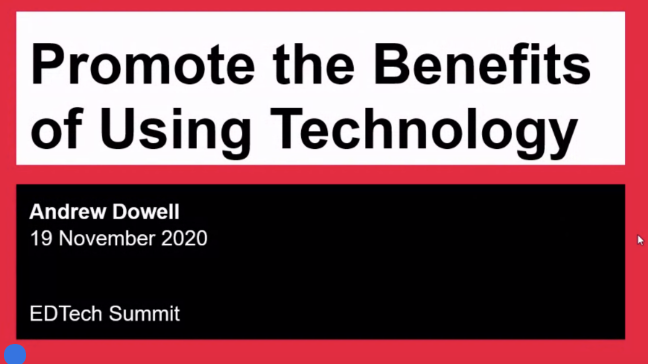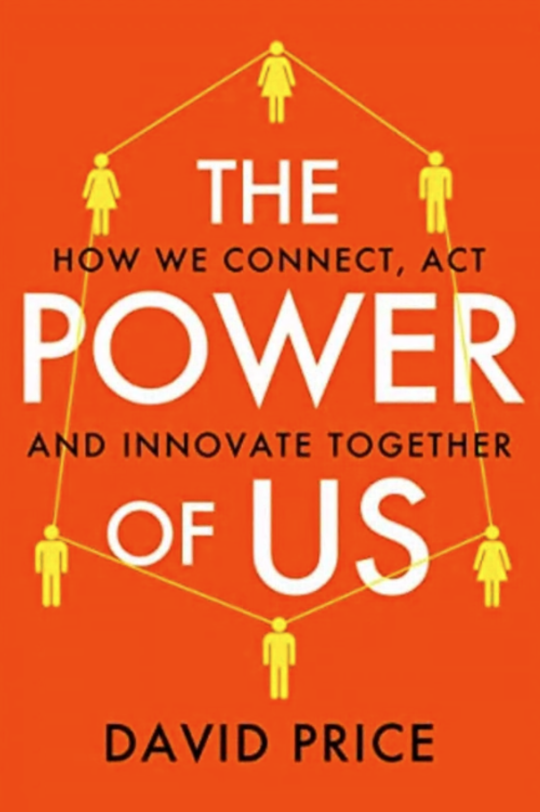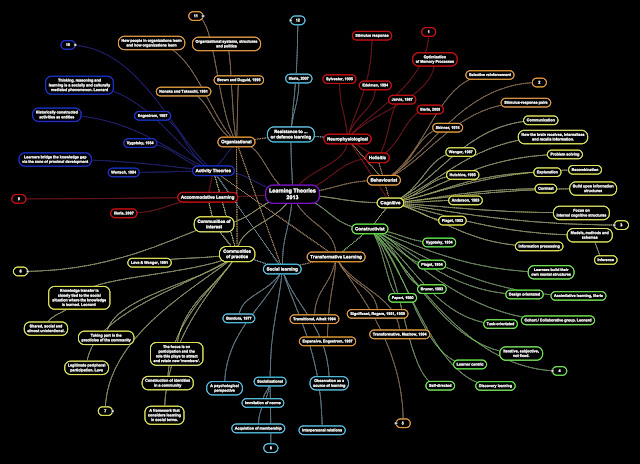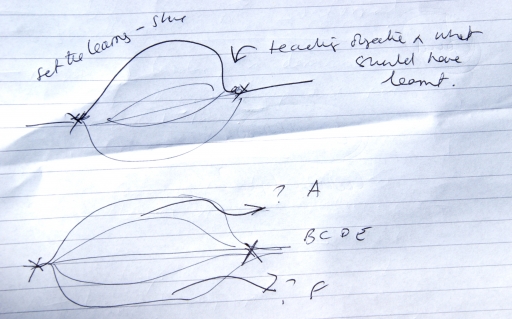Understanding & Using Educational Theories
Karl Aubrey & Alison Riley (2nd Edition) London, Sage (2019)
Harvard Reference
Aubrey. K & Riley. A (2019) Understanding & Using Educational Theories: (2nd Edition) London, Sage
- Benjamin Bloom: Learning through taxonomies
- Albert Bandura. Learning through observation.
- David Kolb: Experiential Learning Theory
- Guy Claxton: Learning Power
- Dylan Wiliam: Assessment for Learning
- Carol Dweck: Mindsets and Motivation
+ Three new chapters which follow the same format as the same edition:
- Albert Bandura
- Dylan Wiliam
- Carol Dweck
Teaching … 'a complex and messy phenomenon, with a multitude of contrasting facets to take into account which need a reflective and professional approach, involving ‘not just knowing what you do and how to do it. It is also about why you do it’. (p xiii Wiliams, 2008) (p.2)
Behaviourism, constructivism, and humanism.
There are three main psychological schools of thought which are of relevance to education and learning theory: behaviourism, constructivism, and humanism.
Learning is simply a matter of stimulus and response (Wallace, 2008:32) (p.2)
Constructivists
The constructivists believe that meaningful knowledge and understanding are actively constructed by learners … which builds on what they already know, causing them to change and adapt and invent ideas’. (Wallace, 2008:61)
Humanists
The humanism school of thought argues that education should focus on the needs of the individual learner, and that what is important are the aspects of personal and emotional growth. (p.3)
Humanists contend that the purpose of schools is to ‘meet the needs of the individual learner not the other way around’. (Petty, 1998:8)
John Dewey contended that learning should focus on practical life experiences and social interaction c/p8
For genuine learning to take place learners needed to make independent evaluations based on their interests.
Facilitating learning by encouraging and channelling individual curiosity and motivation so that they can develop intellectually.
Learning as a cycle of experience where lessons are planned and executed based on observation and reflection from their own and their learners’ previous experiences and interests (Woods, 2008)
Wanted schools to accept pupils from different classes, cultures and abilities, schools would lay the foundations for building notions of democracy for children.
Opportunistic for action experience (p.11)
Skills and processes to solve problems.
Hegel - learning, developing through creative and active experience.
Kolb - active experience the groundwork for starting knowledge building process (Elkjaer, 2009)
Subject- Specific Facts and the Basis of Theory are necessary for learning to be created and built; it cannot take place just by active experience.
- Steiner
- Montessori
Plowden Report (1967)
2014 National Curriculum in England was a return to a subject-based approach (p.16)
England-results driven environment teachers as facilitator and co-collaborator calls into question the role of the teacher and their responsibility in terms of achievement and attainment of the learner.
Get your students to think like real scientists or historians. (p.16)
Like a sports coach it is the students who do the practice, provide the effort and create the gains.
Dewey - his standpoint on inclusivity came from him witnessing the damage done by privilege and elitism.
- Reflection
- Effort
- Courage
- Differentiation
- Diversity
- Democracy
The teachers have to know the child very well. (p.18)
The teachers must be knowledgeable of cultural inheritance.
Identify the problem.
Experiential learning
Lifelong learning
Vocational education
C2 Montessori
- Tap into thor individual needs.
- Respect
- Respond to their needs.
NOTE :> Intrinsic motivation (Roopnanine and Johnson, 2005)
C3 Piaget
- Constructors of their own knowledge.
- Making meaning from experiences.
Vygotsky - social interactions are essential for learning to take place. (p.46)
Earlier physical and intellectual maturity (p.47)
Less formality - children learning in groups + some are more knowledgeable.
@ Secondary - activity which involves abstract reasoning, allowing pupils to demonstrate their concrete thinking.
Adaptation - learning through adjusting to new information and experiences, and can proceed through either assimilation or accommodation.
Lev Vygotsky - (p58)
Social background and construction of … knowledge … which is in tune with the culture within which they mature (Keenon, 2002)
Scaffolding - assistance.
C5 Skipper (p.77)
Vs extrinsic motivation to moderate behaviour.
‘Learning students to find their own pleasure and satisfaction in learning activity proper’. (Richelle, 1993:173)
‘Feedback should be given instantaneously given in order that children are aware of where they went wrong and can rectify this immediately’. (p.79)
C6 Benjamin Bloom
Six hierarchical levels from simple to more complex
The cognitive domain taxonomy
- Knowledge
- Comprehension
- Application
- Analysis
- Synthesis
- Evaluation
- Receiving
- Responding
- Valuing
- Organising
- Conceptualising
- Characterising by value or value concept
The psychomotor domain taxonomy
- Reflex moments
- Perceptual abilities
- Physical abilities
A valuable aid for the planning of lessons, assessments and programmes of study (p.90)
What’s their level of ability at the start of the assignment?
Counter early disappointments.
Modify teaching and learning resources to the individual needs and interests of the student (Husen, 2001)
Develop talent (Bloom, 1976)
Most disadvantaged children … spend less time in direct interaction with their parents than middle-class children do.
Mavlow : Food, Shelter, Safety
Formative Learning
Teaching and assessment so they can all achieve in an already crowded curriculum. (p.93)
Mastery learning in practice takes a huge amount of time and groundwork to prepare resources, plan sessions, organise the classroom environment and give summative feedback to learners (O'Donnell, 2007)
The terms are used to set learning objectives in short-term planning for lessons and medium/long schemes of work. (p94)
Learning objectives (Petty 1998: 347)
- Comprehension
- Application
- Analysis
- Synthesis
- Evaluate
Cognitive : reproductive tasks or reasoning tasks.
Reproduction tasks: knowledge, comprehension, application.
Require low cognitive effort (p.95)
Reasoning Tasks:
Analysis, synthesis and evaluation - involve a deeper learning experience for a student.
Bloom’s taxonomies five teachers a framework to check that their planning and teaching help progress children’s learning. (p.95)
As pupils gain knowledge of their subject, their behaviour and awareness develop, which allows them to use and value the skills attained. (Huddleston and Unwin, 2002)
REF: Bloom, B., Hastings, J. and Madans, G. (eds) Formative and Summative Evaluation of Student Learning. New York. McGraw-Hill.
C7 Malcolm S.Knowles
Contextualising Adult Learning - building on existing experiences.,
Internal gratification from the learning process or the desire to pass exams (p.105)
- Self-concept
- Role of experience
- Readiness to learn
- Orientation for learning
- Internal motivation
- Need to know
Classroom layout withdraws vulnerability predisposes the learner to believe that the delivery style will be one of knowledge transition and possibly reinforce their preconceptions of what constitutes a learning environment. (p.110)
Chairs in circles = collaboration or like the AA to ‘share’.
Away from subject-centeredness to one of problem-centredness.
REF: Knowles, M.S. (1950) Informal Adult Education. New York. Assoc. Press.
C8 Jerome Bruner
‘A Spiral Curriculum’ initial presentation, revisited later on to reinforce understanding and give added vigour.
Three ways children convert experiences: through action, imagery and symbols. (p.118)
Structure of learning and how to make it central to teaching.
Readiness for learning.
Intuitive and analytical thinking.
Motives for learning.
Enactive mode: children do things for themselves.
Iconic mode: comprehend images
Symbolic mode: understand abstract language
REF: Bruner - ‘A scaffold to support the efforts of the learner to construct his or her own understanding’ (Olson, 2007:45)
Olson - margins of a complex task to mastery (2007:46)
Blights of poverty, racism and the inequities of social life. (p.127)
C9 Albert Bandura
> observation of cues by others.
Pay attention
Retention
Reproduce
Motivation to perform an action
‘Most of the behaviours that people display are learned either deliberately through the influence of example’. (Bandura, 1971:5) (p.139)
Pupils achieving success bring others with them.
Behaviour is learned through observing others as rewards for that behaviour. (p.145)
REF: Bandura. A (1977) Social Learning Theory
C10 Urie Bronfenbrenner
Human development was influenced by the social structure that the individual was part of.
People learn from one another:
- Observation
- Replication
- Modelling
C11 Paulo Freire Oppression
Dialogue based on mutual respect curiosity (p.166)
Students keep journals and read out what they write to each other. (p.175)
Interests, cultures, history of 17 year olds.
C12 Donald Schön (1987:31)
- Recalling events
- Feelings
- Evaluating the experience
- Integrating new knowledge
TASK
Make a list of the theories and values that you believe underpin your work in your own setting, then ask a colleague to observe you in practice.
Each student has a fascinating story to tell. (p.91)
Reflective Practice
REF: Boud,. D Keogh, R and Walker, D (eds) 1985
Reflection.
Turning experience into learning.
C13 David Kolb (p.196)
Experiential Learning Theory
What, how and why you do a thing
People learn best when they are engaged in first-hand experiences which can later be reflected as through thinking about the details of the experience alongside the feelings and perceptions which emerged during the experience (Hankin et al, 2001) (p.198)
- Concrete experience
- Reflective observation
- Abstract conceptualisation
- Active experimentation
Fig.13.1 Kolb’s Learning Cycle
REF: Moon, J (1999) Reflection in Learning and Professional Development. London. Kogan Page.
REF: Scön. D (1983) The Reflective Practitioner: How professionals think in practice.
C14 Jean Lave & Etienne Wenger
Learners not passive receivers of knowledge
Wenger’s communities of practice
Wenger (1998)
- Communities of practice
- Mutual engagement
- Joint enterprise
- Shared repertoire
Components:
- Meaning
- Practice
- Community
- Identity
NB. Excessive power interactions hinder admissions and participation.
Blogging
Blogs offer an informal method of writing and give a write the option to air an individual commentary (Rai, 2008:96)
Change layout of the classroom
C15 Guy Claxton
Building student confidence and character.
Process not content
Competence not comprehension
Engagement not ability
Habits of thinking
Reciprocating the behaviour of those they know and trust such as family members and carers.
If children have positive and reasoned experiences which are modelled by these significant others they are more likely to have the emotional intelligence to enable them to work under pressure. (p.231)
Experience in childhood at home and at school is particularly important because these early belief systems whether functional or dysfunctional can be carried through into people’s lives as adults (Claxton, 2002 :122) (p.231)
- Resilient
- Resourceful
- Reflective
- Reciprocal
Teachers need to ‘split-screen’ to retain a dual focus on the content of the lesson and the learning dispositions that are currently being expanded’. (p.237)
Soft creativity
Keep your notes / workings
Keep a blog
Teachers as fallible, inquisitive not know it alls (p.238)
REF: Claxton G & Lucas, B (2004) Being Creative: Essential steps to revitalize your work and life. London. BBC Books.
REF: Gabbert. I. (2002) Essential Motivation in the Classroom. London.
C16 Dylan Wiliam (p.244)
The need for students to assess themselves and understand how to improve.
Students should be involved in the choice of tasks.
Assess each others work
Provide helpful
Comments which would help pupils improve.
By requiring all pupils to respond to questions also increases inclusivity in the classroom (p.253)
Peer assessment was found to be ‘motivating force for pupils, with pupils applying more care to their work knowing that their peers would be assessing it.’ (p.255)
Pupils should be ‘beneficiaries’ rather than victims of testing’. (p.256)
C17 Carol Dweck
Fixed mindset or growth mindset
Dweck promotes the idea that knowing about how the brain works can foster a love of learning and enhance resilience (Pound, 2009)
Praise that celebrates perseverance, effort, study, hard work and the use of learning strategies (Dweck, 2012) (p.267) Brainology
Real learning comes from a lot of hard work (Matthews and Folsom, 2009:22)
“You really tried hard, that was a good way to do it.”





